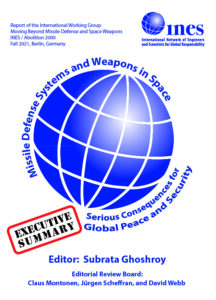Read the executive summary of the report: Executive Summary MDMDS-Report
On November 20, 2000, the U.N. General Assembly, by a vote of 97 to 0 with 65 abstentions, adopted a resolution demanding a comprehensive approach to missiles that would “contribute to international peace and security.” The resolution gave impetus to civil society to take up the issue. One such initiative was a project by the International Network of Engineers and Scientists Against Proliferation (INESAP)1. They produced a report called Beyond Missile Defense by an international team of scientists and policy analysts. Jayantha Dhanapala, then U.N. Under-Secretary General for Disarmament, forwarded the report to the U.N. General Assembly in 2002. They made a number of far-reaching recommendations, summarized later, to develop a verifiable global treaty to ban the development, testing, proliferation, and the acquisition of missiles.
It has been two decades since the above-mentioned U.N. resolution and the publication of the INESAP report. During this time there has been little or no action toward controlling missiles and missile defense systems. On the contrary, a signal event took place within a short time after the U.N. resolution. It was the U.S. unilateral withdrawal on July 1, 2002 from the Anti-Ballistic
Missile (ABM) Treaty, which served for thirty years as a landmark in the history of arms control agreements. In the post-ABM treaty years, there has been proliferation of both missiles and missile defense systems. Our focus for this report is global missile defense systems, because of their adverse impact on strategic stability.
Similar to the previous effort, INES organized anew an international working group in the summer of 2016 to study the consequences for international peace and security resulting from both the ongoing development and deployment of missile defense systems globally as well as the programs to develop weapons in space. From the start, the group reached a conclusion that, as desirable as it might be, it would not be practical to advocate a global missile ban in the present internationa
l situation. The focus instead should be on banning missile defense systems and space weapons. In a nutshell, this report focuses on two subject areas, namely, missile defense and the weaponization of space. It explores the linkages between the two in the larger context of nuclear arms control and disarmament.
The membership of the working group is described elsewhere. It is important to note that the membership represents a broad spectrum of people who are individually affiliated to civil society organizations and universities. Some are former government officials and others are independent analysts.
Because of unforeseen circumstances, the work of the group could not proceed as planned. The present report is the product of mostly individual efforts in writing specific sections. In addition to the members of the original group, who contributed to the report, we invited several scholars outside the group to contribute. While we generally agree on the broad parameters of our analysis, it is by no means a consensus document. Therefore, the views expressed in the articles are solely those of the respective authors.
Download the Sections of the Report
- The 2001-2006 INESAP project Moving Beyond Missile Defense
A brief summary – Jürgen Scheffran - The U.S. missile defense systems – history, politics, waste, and fraud
- The Anti-Ballistic Missile Treaty
The impact of the ABM treaty on the nuclear arms race – Claus Montonen - The U.S. missile defense programs
The status of the U.S. missile defense programs – Christian Alwardt - European and NATO Missile Defense Programs
The Deployment of missile defense systems and its implications for European Security and Nuclear Disarmament – Götz Neuneck - Missile proliferation and missile defense systems in East Asia
Missile Proliferation and the Security Dilemma in East Asia – Masako Ikegami - A critical examination of the U.S. missile defense program: a view from Moscow
Evolution of the U.S, Missile Defense Systems: a Russian Perspective – Vladimir Kozin - Ballistic Missile and Missile Defense programs in India
Ballistic Missile and Ballistic Missile Defense capability in India – Rajaram Nagappa - The evolution of the public perception of space as a battleground
Public Acceptance of Space as a Battleground – Monica Zoppe - Preventing weaponization and an arms race in outer space
Prevention of Arms Race in Outer Space: obstacles and options – Dave Webb and Jürgen Scheffran - Weaponization of space: a view from India
India and weaponization of space – Rajaram Nagappa - The interchangeability of antisatellite and missile defense systems
Anti-Satellite Weapons and Ballistic Missile Defense: the Siamese Twins? – Dave Webb and Jürgen Scheffran - Weaponization of space: a Russian view
The United States seeks domination in space – Vladimir Kozin - Nuclear weapons, disarmament, and missile defense: a Chinese perspective
China’s nuclear weapons strategy and modernization program – Hui Zhang - The Pentagon’s secret X-37B space plane program tocdevelop space weapons technology
X-37B: Backdoor weaponization of space? – Subrata Ghoshroy - International Control of Delivery Systems: Towards a Ballistic Missile Ban
Jürgen Scheffran
Do you want to have printed copies of the executive summary of the report?
Please contact us at lucas.wirl@inesglobal.net.

